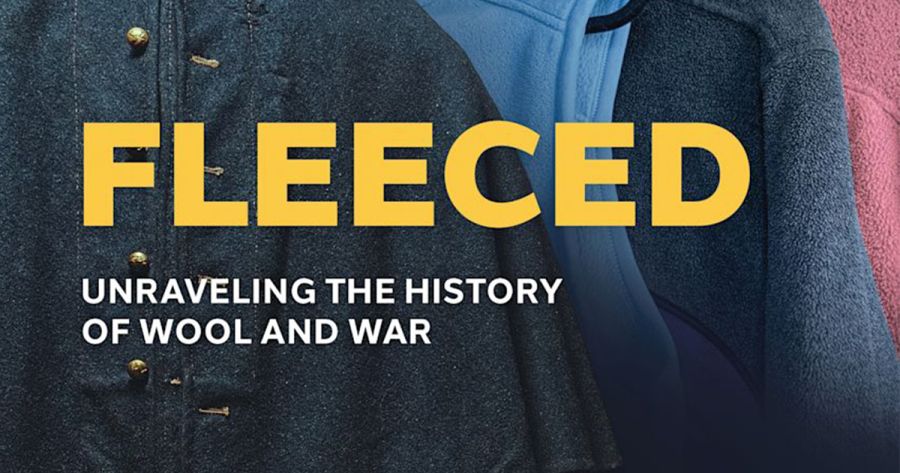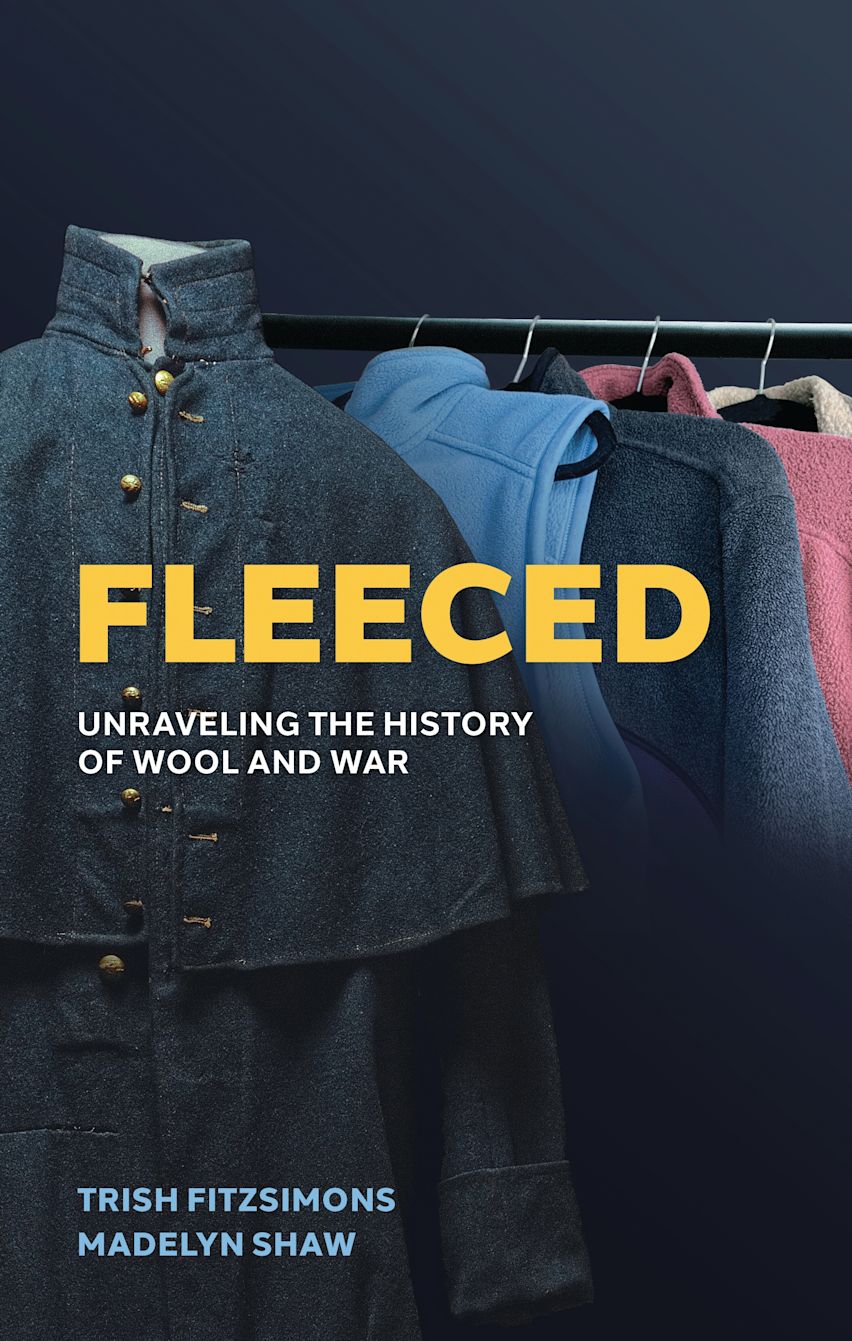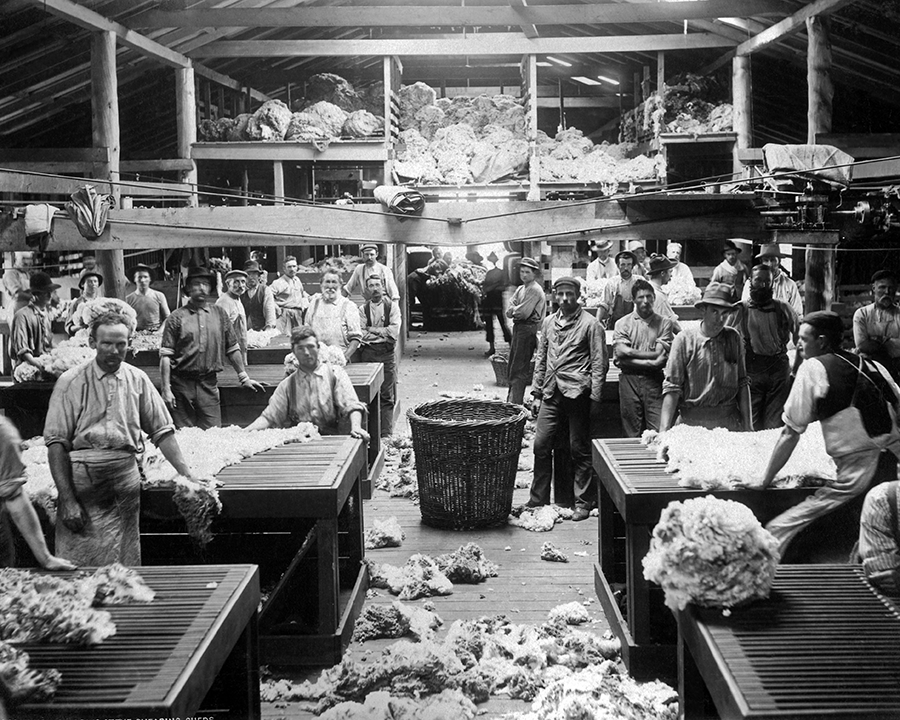
- Free Article: No
- Contents Category: History
- Review Article: Yes
- Article Title: Unwitting vanguard
- Article Subtitle: History on the sheep’s back
- Online Only: No
- Custom Highlight Text:
As Mark Twain tells the story in Following the Equator (1897), Cecil Rhodes, the future magnate and politician, was down and out in Sydney in 1870. Wandering along a harbour beach, he stopped to help a fisherman land and gut a shark – in whose stomach cavity he discovered a fragment of newsprint that, days in advance of sailing ships carrying the same papers, announced the outbreak of the Franco-Prussian War. Galvanised by this intelligence, Rhodes convinced a local wool broker to lend him the money to buy up much of that year’s Australian woolclip, a purchase that helped the future poster boy of Empire get back in the game.
- Book 1 Title: Fleeced
- Book 1 Subtitle: Unravelling the history of wool and war
- Book 1 Biblio: Rowman & Littlefield, $45 hb, 224 pp
- Book 1 Cover Small (400 x 600):

- Book 1 Cover (800 x 1200):

- Book 1 Readings Link: https://www.readings.com.au/product/9798881803803/fleeced--trish-fitzsimons-madelyn-shaw--2025--9798881803803#rac:jokjjzr6ly9m
Twain’s droll point was that the shark was a faster news source than the sailing clippers. But for Trish FitzSimons and Madelyn Shaw, the authors of Fleeced: Unravelling the history of wool and war, the same story, related early on in Fleeced’s pages, expresses a profound truth: ‘for at least a century, from the Crimean War to the Korean War, wool was a vital strategic military commodity, like steel or gunpowder’.
The question that flows from this understanding is why have we not more clearly regarded wool in this light? Answering it explains, in part, why Fleeced is the fruit of an interdisciplinary collaboration between a textile artist and a historian and documentary filmmaker. Because wool is a material whose affective associations are at variance with its wartime utility. To get from the sheep’s back to the Western Front requires an imaginative leap as much as an intellectual one.
 Wool sorting and classing in a shearing shed, Burrawang, New South Wales, c. 1890 (Chronicle/Alamy)
Wool sorting and classing in a shearing shed, Burrawang, New South Wales, c. 1890 (Chronicle/Alamy)
A poignant symbol of this disjunction opens the volume: a pair of knitted woollen gloves, half-finished but abandoned by the Queensland mother of a young man fighting on the Western Front. After the woman had learned of her son’s death in 1914, she put the knitting aside. As the authors explain, wool was the material par excellence for Australian troops in a European winter.
Historically, wool’s physical characteristics have given the textiles made from it a special, and especially multivalent, place in wartime. It is literally warm and fuzzy. Wool cloth holds warmth even when wet. Although wet wool has its own odour, it resists picking up human body odour, and it’s naturally flame resistant. Wool is tough, withstanding even a frontline soldier’s hard use and constant wear. It takes dyes easily, which is useful for differentiating between armies or among ranks or specialties. And, importantly, it is a renewable natural resource.
But as that image suggests, wool had another dimension on the domestic front. While mothers, wives, girlfriends, and sisters might have been physically removed from the field of battle, their knitting of socks, gloves, mittens, scarves, and caps for the troops was a practical civilian effort and a gesture of love from a long distance. All contributed from a sense of patriotism, a need to feel useful, and a hope that their actions might mitigate, in some small way, the misery of war, while reassuring those in harm’s way that they had not been forgotten at home.
Practical and emotional labour was blended, and not just out of necessity for the troops. The authors quote the head of the Textiles Branch of the US government’s War Production Board during World War II: ‘wool is considered a strategic fiber not only for the military front but for the health and morale of the home front’.
Fleeced takes this cleavage seriously. Having set out their thesis in the opening chapter titled ‘Wool: A fabric of war’, the pair set out over seven further chapters and an epilogue to trace the centrality of wool from the Crimean War to the rise of synthetic fibres in the late twentieth century. They reveal wool to be both symbolically freighted and an ever-present facet of daily life: at once a commodity that operated a central node in the geopolitical, industrial, and environmental structures of nineteenth- and twentieth-century history, and a cultural artefact with deep affective roots. Think of Fleeced as microhistory in the spirit of Claudio Magris, welded to the global historiography of Sven Beckert’s Empire of Cotton (2014).
Indeed, each of the book’s chapters are structured around material artifacts, a prism through which broader histories are refracted. A single unfinished pair of socks, a regimental overcoat, or a makeshift POW blanket is treated with the same interpretive gravity as economic data and military decrees. This object-led historical method lends the book a curatorial intimacy even as it proceeds with due critical rigour.
Particularly significant for Antipodean readers is Fleeced’s engagement with wool’s colonial origins. In chapters such as ‘Golden Fleece/White Wealth’ and ‘Agents of Empire’, FitzSimons and Shaw explore how wool underwrote settler colonialism, especially in Australia and New Zealand. Traditional economic history relating to sheep and pastoralism is hardly thin on the ground locally. But unlike, say, Geoffrey Blainey, A.G.L. Shaw, or N.G. Butlin – whose historiography, whether nationalist or quantitative in approach, was not concerned with addressing the experiences of Indigenous Australians – FitzSimons and Shaw describe wool as not just enabling emergent nationhood or economic growth, but also violent dispossession.
The wool industry emerges here not as a neutral field of agricultural practice but as an engine of extraction and a vector of imperial ambition. As the authors put it, ‘land wars between indigenous inhabitants and the colonist-invaders who wanted their land to raise sheep occurred in many parts of the world’. That process unfolded with unique awfulness in the Australian context. Ours was a continental invasion in which sheep were the unwitting vanguard as well as the victorious occupiers.
Even more fascinating than wool’s rise, perhaps, is the story of its demise. Chapter 5, ‘Ersatz and All That’, introduces the rise of synthetic fibres not merely as a technological shift but as an ideological one – a turn from natural to synthetic, from labour-intensive to petrochemical, from repairable to disposable. The authors track how, beginning in World War II, nylon and polyester began to displace wool in both military and civilian life. This transition was not inevitable but politically and economically engineered. ‘We were young adults before the fully synthetic “test-tube” fibers ... took over much of the textiles market,’ they note, highlighting the swiftness of this cultural and environmental shift.
The final chapters, especially the epilogue, ‘Wool and the War on Waste’, bring the narrative into the present. The authors argue that the dominance of synthetics has led to a proliferation of microplastic pollution, so linking fashion history to ecological crisis. Yet the tone remains constructive rather than despairing. They not only ask what was lost with the decline of wool, but what might yet be recovered: sustainability, circularity, and
a reconnection with material labour.
Fleeced is a love letter to wool and a fine act of synthesis. It moves with agility between continents, war zones, and spinning rooms, between archival fragments and industrial data. Yet it remains grounded in the tangible world: in the felted thickness of a uniform, the weight of a bale of wool, the act of knitting. It is rare to find a book that manages to be at once global in scope and locally grounded, analytically sharp yet warm in tone.


Comments powered by CComment